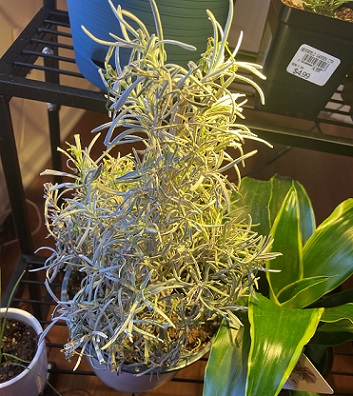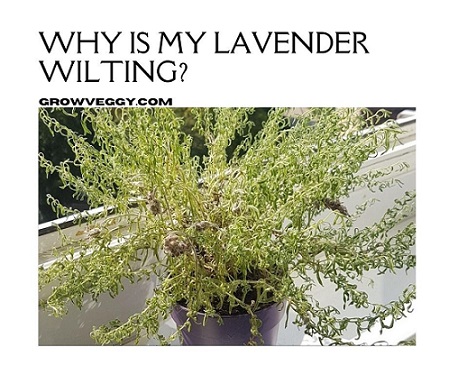Lavender makes for an appealing garden plant. It does well in sunny hot climates with little water requirement. When cared for properly it can live for years and provides an appealing, scenic, and aromatic experience!
Wilting in lavender is the first and most obvious sign of stress! Lavender wilts when the conditions are not suitable for growth.
Deviations in the environment that cause wilting include watering, climate, pot choice, soil, and sunlight intensity.
A lavender plant that has undergone transplanting is prone to wilting because it has to adjust to its new conditions.
This adaption could take a week or longer! The plant has to develop and strengthen its root system.
Factors Responsible for Lavender Wilting
Every plant reacts differently to transplanting and to a change in its conditions. But, lavender tends to be much more sensitive to these changes than most plants.
These are some situations that lead to lavender leaves wilting with tips to solve lavender wilting.
1. Temporary Lavender Wilting Due To Heat
It is normal for lavender to wilt in extremely hot conditions in an attempt to adapt to the temperature change. Especially if the previous day was much cooler.
If your lavender has suddenly started to wilt, temperature could be the reason.
All lavender variants are naturally capable of thriving in hot and dry conditions with infrequent watering habits.
But that doesn’t mean that lavender can handle excessively high temperatures without showing some side effects.
When lavender wilts due to high temperatures the plant will recover and often would not be affected in any negative way.
Solution
Do not immediately assume your lavender needs water! If it turns out the plant is not dry, you could end up overwatering it causing more severe problems.
Instead, wait till the evening and observe your lavender plant. By the evening temperatures will likely subside and wilting may reduce.
Also, take note of the temperature at the time of wilting and after wilting subsides.
There should be a notable difference between the two temperatures. This acts as a way to identify and prove that temperature changes were the cause of wilting.
2. Overwatering Causes Lavender Wilting
Lavender is one of those plants that have the least water requirements.
Providing them with a bit more than required may lead to their death. This makes it unsurprising that overwatering is the leading cause of lavender wilting.
These plants are often said to be drought resistant and mainly like the Mediterranean climate from which they originate.
Infrequent watering every 2 weeks is fine as long as the soil is sandy and there has not been rainfall recently.
If the soil is not of the right composition, water will not drain well, leaving the soil wet.
Damp soil and high temperatures are the perfect conditions for fungal growth and deterioration of roots through root rot.
Signs of overwatering and root rot are wilting, browning, and yellowing of foliage from the bottom upwards.
Unfortunately, many people confuse these symptoms with a lack of water! Giving the lavender then creates more problems and the plant may eventually die off.
Solution
The best way to avoid overwatering (or underwatering) your lavender plant is to stick to a watering plan.
This plan may not always be every 2 weeks. Many factors decide this watering routine, but the most important one is the climate.
- Hot Climate
All hot climates are where a lavender plant will thrive and bloom well when its other requirements are met. In hot climates, lavender requires watering every 2 weeks, nothing sooner!
Potted lavender may require more frequent watering because it drains out faster than ground lavender.
- Temperate Climate
In temperate regions that receive rainfall and have constant cloudy and overcast weather, established lavender plants may not need watering.
If rainfall is scarce and there is a drought, you may have to continue watering.
3. Lavender Wilting After Transplantation
When planting a new lavender or transplanting an existing plant, conditions will change. The plant has to adapt to a completely new environment!
As a result of transplantation, your plant will show signs of stress initially. The most common sign is wilting or drooping of leaves.
Luckily lavenders are quite strong and will survive and bounce back from such stressful conditions.
The wilting is only temporary and is commonly known as ‘transplant shock’. The cause of the shock is due to a change in:
- Temperature
- Humidity
- Soil type
- Watering frequency
- Sun availability and intensity
The lavender you transplant will need a week or so to acclimatize to the new conditions which are much different from the previous conditions.
Solution
After transplanting a lavender plant (to a pot or the ground) water it immediately to avoid or decrease wilting. But giving it too much water will induce wilting!
Do not water the lavender for another week unless you feel the soil and it is very dry.
4. Lavender Wilting Due To Incorrect Soil
Naturally, people tend to give their plants nutrient-rich soil, or even fertilizer to promote growth and flowering.
However, this does not apply to lavender! Overly rich soil will cause a lavender plant to wilt or droop; it also affects flowering.
Lavender likes soil that is low to medium in nutrients and has a basic pH of 6.5 up.
In addition to making the plant wilt, too many nutrients can cause a lavender plant to become leggy and leaves to become yellow.
Flowers will not bloom because all nutrients are taken up by the foliage.
Solution
Check your soil beforehand with a nutrient soil test kit. It should be of low to medium nutrient value.
If not, you need to personally amend the soil to suit your lavender plant. This can be done by adjusting the soil component ratios.
Add a higher quantity of porous materials such as sand or gravel.
For one, stop applying fertilizer and organic nutrient-rich material to the plant.
This is what is causing the negative effects such as the overgrowth of foliage. This leads to conditions such as leggy growth that looks unappealing.
Use soil with high drainage and low to moderate nutrient levels, this qualifies as poor soil.
Try to get or make sandy and gravel soils that allow water to easily pass out rapidly. This way root rot will not be a problem to worry about.
Another factor to consider is pH. Lavender has a specific requirement for high pH levels, that is basic pH ranging from 6.5 to 7.5.
Acidic conditions that are anything below pH 5 are inappropriate since they can affect lavender growth.
5. Wilting Due To Lack of Sun
Sun is basic essentiality for all plants to synthesize food via photosynthesis. So understandably, a lack of sunlight can kill a plant and there is no revival solution for that!
It may seem odd but lack of sunlight can drastically affect a lavender plant, it can even cause wilting in severe cases. Lavender needs full sunlight and there are no ways to compromise!
Solution
Have a look in your garden for that area that has sun throughout the day. This is where your lavender plant should be grown.
If you have a pot, you can change the placement to some extent. This gives it a fighting chance to survive if you don’t always have sunny weather.

Wilting Potted Lavender
Lavender grown in a flower pot has slightly more requirements than lavender grown in the ground. This is because the pot needs to be appropriate.
Reasons for potted lavender wilting are:
a. Incorrect pot material
Pots made from materials like metal and plastic tend to conduct heat better than materials such as terracotta or clay.
This means that lavender will heat up and dry faster in a metal/plastic container than in a clay/terracotta pot.
Terracotta and clay pots are better since they are weather-hardy and can protect against frost to some extent.
However, they may not dry the soil out as fast as metal and plastic pots. As a result, you should not water your lavender frequently.
b. Poor Drainage
Does your lavender pot have drainage holes at the bottom? Is there a dripping tray beneath the pot?
These are questions that can affect the outcome of your lavender plant. Lavender pot drainage holes are important to get rid of water since these plants hate dampness.
Putting a dripping tray will only aggravate the situation and keep the soil wet! Make sure there are no puddles under the pots after watering. If there are, change the location of the pot.
Use sand or gravel-based soil only! Using regular soil or clay soils will lead to an accumulation of water that can kill your lavender.
If your plant pot is not draining fast enough or at all, you may have to put more drainage holes. Or amend the soil mix to suit the lavender.
c. Size of Pot
Lavender prefers larger pots since their roots need space to establish themselves and support the plant.
Pots with a bigger capacity help to insulate the roots and this helps the plant to survive winter.
The ideal pot for planting lavender should be between 12 and 16 inches in width and depth.
Anything shallower than this will not be enough for lavender and it may strangle the roots that need more space.
d. Pot Location
Lavender loves the sun and nothing less than the full sun will suffice. Position your lavender pot in an open space that will not fall in the shadow of buildings or taller plants.
If you have a smaller pot, it may dry out faster, and compensating it by putting it in a shady place will not work!
Instead, transplant the lavender to a larger pot and make sure it gets full sunlight for long hours (the majority of the day).
Lack of sunlight may stunt your lavender and flower output will be poor.
During the rainy season, make sure that the lavender pot is out of the rain. Bring it indoors if possible!
Conclusion
Wilting in lavender is a serious issue that needs your attention. Failure to do so could lead to no flowers or even the death of your plant.
There are a few common reasons and some that are not so common.
Either way, finding the solution is important if you want your lavender to survive. And also if you want it to bloom and reap the rewards of lavender flowers!
FAQs
Why Is my lavender plant drooping?
Droopy lavender plants are not a sign of overwatering! Instead, it is a sign of overwatering or too many nutrients. There may be too much water in the soil or even an excessive amount of nutrients in the soil.
Can you revive overwatered lavender?
This depends on how long it takes you to discover the lavender is wilting due to too much water! If it is too late your lavender plant can easily die.
Stop watering the plant, transplant it, and check for root rot. Remove the rotten root portions. Taking these steps may help to revive the lavender but cannot guarantee a full recovery.

